CiM Tester Feedback
-
Some customers reported that Gunmetal's lustre washes off in soap and water.
"All 3 goddesses to the right were subjected to the same soaking and scrubbing regime to test how much lustre wears off. The first bead is Gunmetal and not worked that long in the flame - the lustre has really really rubbed off and its mostly black. The second bead is Gunmetal and was worked longer in the flame than the first - the lustre has only rubbed off at the bottom of the legs and a bit on the goddesses breasts. The third bead is effetre silver plum, and was worked as long as the first Gunmetal bead, so not too long. Some lustre has worn off, but very very little compared to the Gunmetal. One thing I did notice is that the longer you worked an item and the thinner the Gunmetal was the more the lustre stays. The thicker and larger it is the more likely it is to rub off. I think it seems to be how you work it that makes the difference, that maybe why some people have had the issue and some not." – Claire Morris
"I made two beads with Hades cores, covered in Gunmetal frit. One annealed bead was soaked for 4+ hours in chlorinated tap water. The other bead was kept dry as a control/comparison. Using a green scrub pad, dish soap, and chlorinated tap water, I scrubbed vigorously over one specific spot on the soaked bead for a period of 90 seconds. At 30 seconds, there was no visible difference between the beads. At 60 seconds, the finish was very slightly faded. At 90 seconds, there was approximately a 50% loss of finish. I would suspect that the user who reported the loss of color most likely did not expose the bead surface to the proper flame chemistry for a long enough period of time. I generally take the metallic black type glass, all 3 brands that I have tried, to multiple cycles of raising the metallic surface, returning it just barely to shiny, and back to metallic. My thinking is that this should produce a slightly thicker and therefore more durable metallic finish." – Kathy Coon
"I tested Gunmetal and washed and scrubbed with Dawn dish soap and the finish does NOT come off. I scrubbed with a towel, dried and rewashed again and the shiny metallic finish is still there." – Sue Stewart
"I also tried several experiments, trying to see if I had any trouble with losing the metallic finish when exposing it to soap and water. So far, nothing I’ve tried has removed the finish, except for when I soaked it for about 15 minutes in toilet bowl cleaner." – Lori Bergmann
"All you folks who soak your beads in caustic substances are always taking a chance on having the surface eaten off when you soak a bead that has a reactive glass on the surface. When a shiny or rainbow reactive glass surface is produced on a bead, you have to understand that the reactive surface is very thin only a few micron on the surface of the glass and it can be altered with amazing ease. If you really want to protect the surface of your reactive beads, you need to seal the bead surface with finger nail polish or some clear sealant to stop surface erosion." – Patricia Frantz
"Left them soaking in water and detergent for over 4 hours, testing periodically if the surface patina could be rubbed off at all. Neither batch showed any degradation at all. This is for beads that are wholly Gunmetal and also those with Gunmetal shards. In the case of the beads made wholly with Gunmetal I created the surface patina by flashing through an oxy rich flame repeatedly. In the case of the shard beads the patina was created in an oxy rich flame as I laid on the shards and not flashed through the oxy flame again." – Jolene Wolfe
"I tend to work beads in the flame a lot, so have not had any troubles with the finish on struck beads coming off." – Carol Oliver
"One thing I noticed on all of the beads is that if I 'bounced' the bead rapidly in the flame, it would produce a 'pearly' luster. Coming out of the kiln, if you rub the surface, this 'pearl' effect is removed, but it doesn't always remove the metallic shine, although sometimes it does [weird]. So, I'm working on a theory that, as some others on LE had commented, if the metallic surface doesn't get 'baked' on, it might not stay. When I 'bounce' the bead rapidly in the flame, the glass stays cooler, even though it produces a nice shine, so maybe this method makes the surface coating more delicate. I know many artists use the bounce method to get other silver glasses to shine the best." – Renee Wiggins
"I made some beads yesterday: 3 'quick passes' and 3 'normal time' beads. The 'quick passes' yes, the shine came off just soaking a night in water. Not around the hole though. It's 'cooked' a little more there so another point for 'cooking it' theory. The 'normal amount of time' beads, the shine did not rub off for me. But here's the thing, I can't say ALL because I haven't tried or tested all, but shine from metallic glasses will wear off over time is what I found with my daily wear items." – Elasia
-
Testers had mixed feelings about whether or not Gunmetal was easy to strike.
"The difference between regular Gunmetal and 511885-1 Unique Gunmetal is that regular Gunmetal is easier to strike. The 885-1 yielded the same results but took longer to do so." – Genea Crivello
"A neutral or oxidizing flame works best. Whether your flame is neutral, oxidizing, or reducing, you must flick your bead in the tip of the flame for striking. But even with the proper working atmosphere, it is difficult to strike the entire bead- you are likely to get little streakies of just plain old black." – Patricia Frantz
"Using this glass is so easy. I found a neutral if not slightly oxidizing flame works best, and also if the glass itself has just a little time to cool before getting "struck" silver. The shine will go away in a reducing flame, but can be brought back easily again in the neutral flame." – Renee Wiggins
"Talk about frustration – I found it all but impossible to strike a bead evenly. Most came out of the kiln ½ shiny, marks around it – just yuck. When I worked it extremely cool and made small spacers, it turned to a matte finish all by itself. I gave up – I really wanted it to work!" – Donna Dorman
"I don’t have a problem with striking Gunmetal as long as it goes over a clear core. Trying to get the silver shine is almost impossible to keep, using it by itself. I find if you get the shine, STOP. It likes to be worked cool and high in the flame." – Sue Stewart
"Big disappointment. Reducing to pull the sheen up was easy. Keeping it longer than a week is not possible. It wears off." – Starleen Colon
"No problem [striking] for me. I love this color. I did make a comparison bead using Gunmetal and Black Metallic. Black Metallic produces copper shades and the Gunmetal does not. Gunmetal is a wonder glass. Easy to strike and very shiny." – Jan Whitesel-Keeton
"No problems getting the basic matte gray color, but I was disappointed when I couldn’t get all of the nice colors out of it that happen with Effetre Metallic Black. Gunmetal just ended up being…..well…gun metal colored! Not a bad thing, though. Prefer Gunmetal when I want to make several beads that match, which is harder to do with the Italian." – Kathy Coon
"No problem [striking] at all, but Gunmetal is very soft and it was hard for me to maintain the shape of my bead while working on one area because the whole bead would heat up so quickly." – Elizabeth Long
"I made three beads and couldn’t get any of them to totally strike. Just parts of them struck, but they looked good. I’d say I could get about 40-60% struck on each one." – Marcy Lamberson
"The lustre appeared as soon as I melted it, sometimes after working too long it would disappear - but it could easily be re-lustred by placing at the back of a slightly oxidising flame. I also found the lustre improved after annealing." – Claire Morris
"Sometimes I have a little more trouble coaxing out the silver consistently. I got results quicker and easier when I used the Gunmetal on pressed shapes. I’m thinking the rapid cooling from the brass press and reheating helps? If working with a non-pressed shape, I had to let it cool down until the glow was totally gone and strike it by rolling it in a slightly oxidizing flame. I also noticed that I got just a hint of a bronze tone when I worked with a highly oxidizing flame. I'm sure that it's more a matter of making sure you heat and cool the Gunmetal several times and give it a chance to have the finish really "soak" in after it's been struck too. None of that microsecond wafting stuff!" – Lori Bergmann
"Gunmetal strikes easily for me. I like that you can control the metallic sheen easier than the Italian Silver Plum. You can easily remove the sheen and recreate it as you work. It is wonderful. This color works for me!" – Chris Haussler
"I am not so crazy about Gunmetal - maybe I am just used to silver plum. Gunmetal when applied as dots on non CiM glass will react inconsistently - then when on CiM seems to strike really well when worked hot/cool - hot/cool - back and forth. Looks good going into the kiln - but seems to me Gunmetal un strikes in kiln on non-CiM glass." – Vonna Maslanka
"I've found that where in the torch flame you work the glass and strike it has a huge impact on how well, if at all the glass will strike. Working in a neutral flame, if I work about 7" out from the torch face, I can get both Gunmetal and Unique Gunmetal -1 to strike to some extent, while if I work about 3-4" out from the torch face it's very difficult to get any change from either. [see photo to right] I had better results rolling the bead just under the flame instead of bouncing the bead in and out of the flame to get the center to restrike and stay that way. Working far out in a neutral flame gives the best, most consistent results, and I could not get consistent results in an oxidizing flame. Working in a reducing flame gives nothing more than a dull, smokey bead. – Carol Oliver
"I find the best and easiest way to create a strong surface patina with this glass is to flash your finished bead through a very small oxygen rich flame just before putting your bead away in the kiln." – Jolene Wolfe
-
Testers report that Gunmetal's shiny aspect is particularly difficult to photograph.
-
Special thanks to Genea Crivello-Knable, Claire Morris, Carol Oliver, Pat Frantz (x6), Leslie Anne Bitgood (x7), Bonnie Polinski, & Sue Stewart for providing the photos in this section.
"Gunmetal is my all-time FAVORITE black!"
– Joy Munshower
|
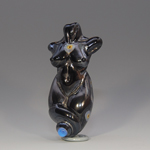
|
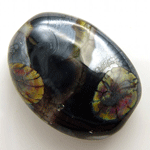
| "It’s baby blue with some Gunmetal on top. Not reduced – you just need to waft the Gunmetal about in a neutral flame and it’ll do its thing." Read more at Heather's blog. |
"This set was created on a base of CiM Gunmetal glass. These are glass beads, but the surface of the glass is amazing in how it transforms to a metallic surface with a range of hues from silver blues to pinks to brassy golds." Read more at Darlene's blog. |
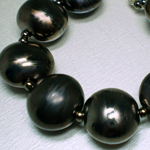
|
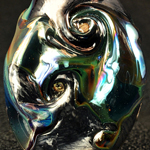
| Gunmetal with Double Helix TE315 test shards.
–
Carol Oliver
|
“On a base of Effetre Violet shards of Dark Silver Plum were carefully added by hand and melted into the surface of the bead to create the metallic marble look. Coordinated with lots of spacer beads of reduced violet and CiM Gunmetal.” Read more at Darlene’s blog. |
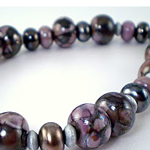
|
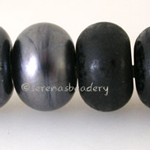
| "The second bead from the left was the first one I made and honestly it had the best appearance after a trip through the kiln. I tried hard to replicate that, but could not get it just so. The others did get shiny and streaky at the same time. Very interesting...They also did not etch very well - they came out all blotchy, but then why would anyone want to remove that gorgeous metallic finish with acid anyhow.” Read more at Serena’s Bead Blog. |
"It turns out that Gunmetal is a rather tricky color to work with and some people on the Lampworker's Etc. online forum reported that the metallic finish could wash or wear off easily. After some extensive testing by myself and others, we've determined that it's all a matter of how well and long you heat this color that brings out the most consistent and durable finish." Read more at Lori's blog. |
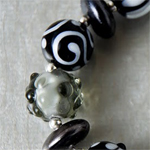
|
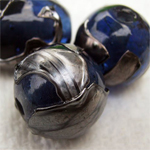
| "As shards, Gunmetal looks a deep transparent purple before application. For the best results I use the same technique to apply as I do with premium Effetre hand pulled Dark Silver Plum DSP. I turn the torch flame right down with the propane dial only, creating a very small oxygen rich flame. The results are instant when you add Gunmetal shards to the surface of your bead, glistening and shiny silver. Very lovely indeed, and at just a fraction of the price of DSP." Read more at Craft Pimp. |
"Gunmetal was used for the smallest dots and managed to answer a problem for me with the design - I was using glasses which wouldn't have liked me using a reduction silver glass but I wanted to have raised dots which were metallic in the piece. Gunmetal helped me out with this as it lustred the moment it was melted in a neutral flame for me, which the other glasses in the bead needed as they would have been affected by reduction flame of secondary silver fuming from a silver glass."
– Claire Morris
|

|
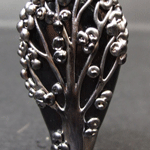
| "This tree was about the 4th one I attempted as the Gunmetal was lustring the moment the stringer became slightly hot - which was inhibiting the stringer sticking to the base bead. On the 4th go, I worked out that to overcome this problem the stringer needed to be worked warmer that I usually would work it. I noticed that on the tree I did, it made the glass just slightly by the Gunmetal stringer devit."
–
Claire Morris
|
"Having made this design both in silver plum [right] and Gunmetal [left], I think the Gunmetal suits the design better as silver plum has a tendency to pit and boil if worked too much whereas the Gunmetal stays smoother and has a more silvery chrome effect. The downside with Gunmetal is that if it isn't worked for a long time the lustre has a tendency to wear off, luckily this piece didn't suffer from it too much. This doesn't happen with silver plum. Gunmetal's lustre comes out very quickly for me, and after working with silver plum I noticed that that doesnt strike to lustre half as quickly as Gunmetal - which was immediate."
– Claire Morris
|
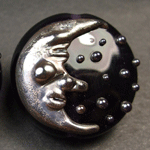
|
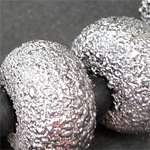
| See JetAge Studio's Gunmetal frit offerings here. "It's super easy to work with no reduction needed. Just apply frit or powder to your bead . . . The silvering effect happens almost immediately! A Few Working Notes: This glass tends to be on the "soft" side, readily spreading with concentrated heat. Also, the silver will disappear if encased, but this can be used in certain applications to create neat designs." |
"Shards and swipes get the best Gunmetal effect. Fine stringer spiders on ivory and gives organic effects without doing anything special. You can also get a bit of shine and I found some blue on one of the ivory based beads. It also seems to love Celadon and silver green frit."
– Leslie Anne Bitgood
|
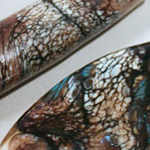
|
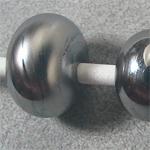
| "It starts as a dark grey rod, but blooms with a silvery, sometimes slightly frosted finish." Read more at Dragon Jools blog. |